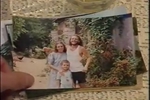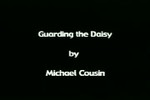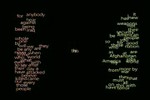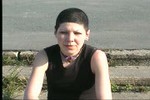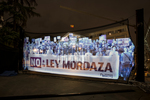
Border Tuner - Antimodular Research
48min.
“Border Tuner” is a large-scale, participatory art installation designed to interconnect El Paso and Ciudad Juárez: powerful robotic searchlights make “bridges of light” that open bidirectional live sound channels for communication across the US-Mexico border. The piece creates a fluid canopy of light that can be modified by visitors to six interactive stations, three placed at Juarez’s Chamizal Park and three at El Paso’s Bowie High School. Each of the interactive stations features a custom-made lectern with a microphone, a speaker and a large knob or dial. As a participant turns the dial, three nearby searchlights create an “arm” of light that follows the movement of the dial, automatically scanning the horizon. When two such “arms of light” meet in the sky and intersect, automatically a bidirectional channel of sound is opened between the people at the two remote stations. As they speak and hear each other, the brightness of the “light bridge” modulates in sync, —a glimmer similar to a Morse code scintillation. When a light bridge is created, the dials are “snapped in place” by a slight clutch resistance: overcoming this haptic resistance allows the participant to tune out of the particular conversation and tune-in to new ones. Every interactive station can tune any other, so for example a participant in Mexico can connect to the three US-based stations or to the other two in Mexico, as they wish.
At the start of the project each night, prior to opening the microphones to the general public, a variety of special guests on both sides will take control of the system. One evening it might be slam poets, another jazz musicians, beatboxers, seniors, indigenous speakers, maker/hackers, choirs, historians, feminists, sports fans, and so on; during these “opening remarks” the piece will be set to a special mode where all the lights intersect and all six stations can hear each other.
When no one is participating, the searchlights for each station form an inverted tetrahedron, - a “flower” formation -, and modulate their intensity reacting to pre-recorded content. This content is curated in conjunction with communities on both sides of the border and is meant to animate the piece permanently with diverse voices that represent the region. The lectern interface, the podium where people participate, was chosen because it already invites people to address others. The lectern will have space for a musician to place a score, or for a poet to place his or her writing, for example.
Contrary to previous Lozano-Hemmer voice activated public works, in this project the lights signal “listening” and tuning. To be heard a participant depends on others to tune him or her in. Once conversations are established they cannot be interrupted by others. The sound-to- light modulation is also different from previous projects: if participants are silent their lights are at full brightness but as they speak their brightness modulates to the inverse of their volume. Loud people shouting will thus have the faintest lights.
“Border Tuner” is not only designed to create new interconnections between the communities on both sides of the border, but to make visible the relationships that are already in place: magnifying existing connections, conversations and culture that are already shared. The piece is intended as a visible “switchboard” of communication where people can self-represent. The piece seeks to provide a platform for a wide-range of local voices and an opportunity to draw international attention to the complicity and interdependence between the sister cities that create the largest binational metropolitan area in the western hemisphere.
The project will be active every night at dusk, November 7 - 24, 2019.
Co-curated by Kerry Doyle (University of Texas at El Paso) and León de la Rosa (Universidad Autónoma de Ciudad Juárez).
For donations or support please contact El Paso Community Foundation epcf.org or Fundación Comunitaria de la Frontera Norte fcfn.org
utep.edu/rubin/program-outreach/border-turner.html
facebook.com/bordertuner
instagram.com/bordertuner
twitter.com/BorderTuner
lozano-hemmer.com
ABC https://is.gd/w5wesr
FOX https://is.gd/bSt2FK
TELEMUNDO https://is.gd/oYteZ3
NYTIMES https://is.gd/XaWHBO
EL PASO HERALD POST https://is.gd/utmoez
MUY JUARENSE https://is.gd/pksIHY
EL UNIVERSAL https://is.gd/xOriKJ
REFORMA https://is.gd/irbzuK
El video y la información en español está en esta página: vimeo.com/338489342
Source:
https://vimeo.com/336228833






